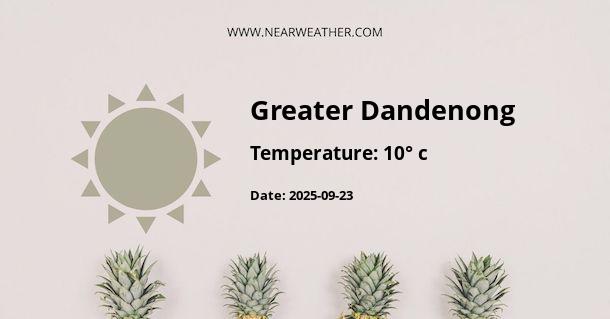Climate and Weather in Greater Dandenong, AU
Greater Dandenong, located in the southeastern suburbs of Melbourne, Australia, experiences a temperate climate with distinct four seasons. The region, known for its diverse cultural mix and vibrant communities, enjoys moderate temperatures and varied precipitation patterns throughout the year. Understanding the climate and weather patterns in Greater Dandenong is essential for residents, travelers, and businesses alike.
Temperature
The average annual temperature in Greater Dandenong ranges from 11°C to 20°C, with January typically being the warmest month and July the coolest. Summers are mild to warm, with average high temperatures reaching around 26°C, while winters are cool, with average lows dropping to around 6°C. The region experiences a relatively moderate climate, making it comfortable for outdoor activities throughout most of the year.
Precipitation
Greater Dandenong receives an average annual rainfall of approximately 900mm, with the highest precipitation occurring during the winter months. The wettest period is usually from May to October, with June being the wettest month. On the other hand, summers are relatively drier, with occasional short bursts of rainfall. The varied precipitation patterns contribute to the lush greenery and vibrant flora that characterize the region.
Seasonal Overview
Understanding the seasonal changes in Greater Dandenong provides valuable insights into the weather patterns throughout the year:
| Season | Average Temperature (°C) | Precipitation |
|---|---|---|
| Spring (September - November) | 11°C - 20°C | Moderate rainfall, increasing temperatures |
| Summer (December - February) | 14°C - 26°C | Warm and dry, occasional thunderstorms |
| Autumn (March - May) | 11°C - 20°C | Mild temperatures, decreasing rainfall |
| Winter (June - August) | 6°C - 14°C | Cool and wet, occasional frosts |
Weather Events
While Greater Dandenong generally experiences mild and pleasant weather, certain weather events can impact the region. In summer, occasional heatwaves can result in elevated temperatures, requiring precautions to prevent heat-related illnesses. Additionally, thunderstorms with gusty winds and lightning may occur during the warmer months. In winter, occasional frosts can occur, particularly during the early mornings.
Climate Trends and Variability
Analysis of climate trends in Greater Dandenong indicates a subtle increase in average temperatures over the years, aligned with global climate change patterns. This trend underscores the importance of sustainable practices and climate-conscious initiatives to mitigate the potential impacts of rising temperatures and altered precipitation patterns.
Furthermore, ongoing efforts to monitor and address climate variability in the region are essential for adapting to changing weather patterns and ensuring the resilience of Greater Dandenong's communities and ecosystems.
Conclusion
Greater Dandenong's climate and weather offer a blend of seasonal variation, moderate temperatures, and diverse precipitation patterns. Understanding these climatic elements is crucial for residents, businesses, and visitors to prepare for and appreciate the unique weather experiences that the region presents throughout the year.
By being informed about the climate and weather in Greater Dandenong, individuals and organizations can make informed decisions, promote environmental sustainability, and enhance their overall experience in this dynamic and welcoming locale.
A - Greater Dandenong's Latitude is -38.001122 & Longitude is 145.190735.
A - Weather in Greater Dandenong is 10° today.
A - Climate Conditions in Greater Dandenong shows overcast clouds today.
A - Humidity in Greater Dandenong is 84% today.
A - Wind speed in Greater Dandenong is 12.02 km/h, flowing at 302° wind direction. today.
